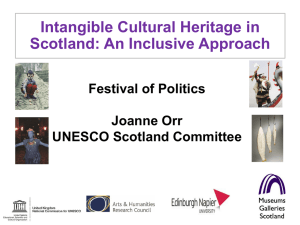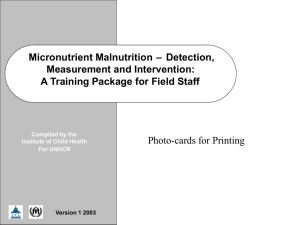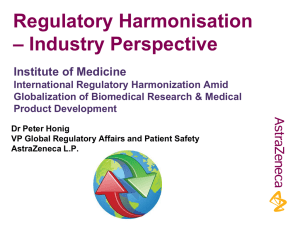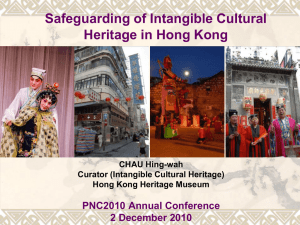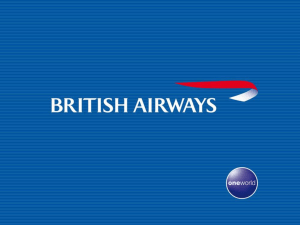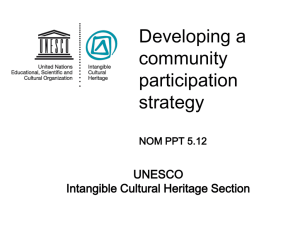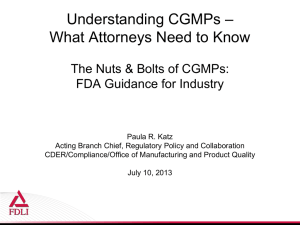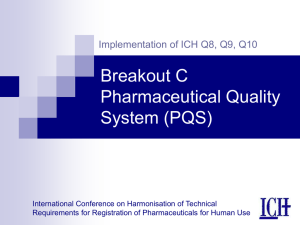International Conference on Harmonization (ICH) and the
advertisement
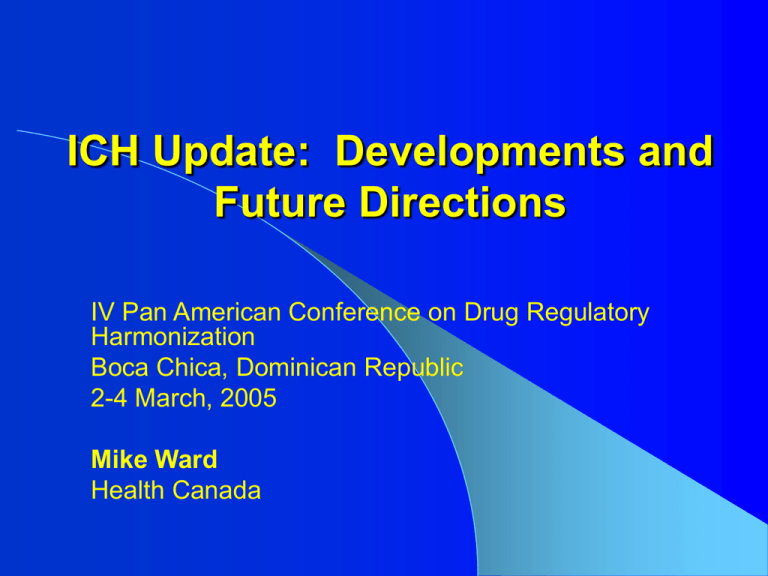
ICH Update: Developments and Future Directions IV Pan American Conference on Drug Regulatory Harmonization Boca Chica, Dominican Republic 2-4 March, 2005 Mike Ward Health Canada A Unique Approach International Conference on Harmonisation (ICH) was created in 1990 Agreement between the EU, Japan and the USA to harmonize different regional requirements for registration of pharmaceutical drug products Unique because joint effort by regulators and associated pharmaceutical industry trade associations ICH Objectives Identification and elimination of the need to duplicate studies to meet different regulatory requirements More efficient use of resources in the R&D process, as a consequence Quicker access for patients to safe and effective new medicines Working Groups SAFETY QUALITY EFFICACY MULTIDISCIPLINARY STEERING COMMITTEE Endorses topics, guidelines and monitors progress Retrospective ICH – a ‘mature’ harmonization initiative Over 50 technical guidelines, a dictionary of medical terms, electronic standards and a common format for drug registration Six ICH conferences to date, including ICH 6 in Osaka, Japan, November 2003 Witnessing increased interest in and use of ICH guidelines globally Formation and evolution of Global Cooperation Group (GCG) Time to Reflect Following over a decade of significant achievements in the harmonization of quality, safety and efficacy requirements for the registration of new drugs in the three ICH regions, is the work of ICH mostly done? Will ICH become a maintenance-only organization? No, however… Appropriate time to evaluate the future of ICH to ensure: – Proper balance between maintenance and new activities – New topics are of high value and objectives are achievable – Most efficient use and management of resources – Flexible enough to deal with evolving science and technologies – More transparent ICH Output since 3rd Pan-Am Conference, April 02 (1) New products: Five technical guidelines: – 3 Quality: Stability (Q1E, Q1F), Biotech comparability (Q5E) – 2 Efficacy: post-approval safety (E2D) and pharmacovigilance planning (E2E) Specifications established for electronic submissions: eCTD Four ‘Considerations’ documents: 3 on gene therapy, 1 on gender and clinical trials ICH Output since 3rd Pan-Am Conference (2) Responding to user needs and new data: maintenance, improvement, clarification activities: – Introduction of question and answers documents (M4CTD/eCTD, E5-ethnic factors, E2B(M)-transmission of safety case reports) – Revision of Quality guidelines on stability (Q1A) and impurities (Q3B) – Maintenance of limits for residual solvents (Q3C) – New addendum to periodic safety update reports (E2C); `granularity` annex to Common Technical Document (CTD) guidance ICH Output since 3rd Pan-Am Conference (3) MedDRA: – Continual improvement: MedDRA version 8.0 scheduled for release March 2005 – Now available in 8 languages, including Spanish and Portuguese – New draft ‘Points to Consider’ documents on term selection and data retrieval/presentation – Release of first Standardized MedDRA Queries (SMQs) – collaboration with Council for International Organization of Medical Services (CIOMS) ICH: Developments and Future Directions `Themes`: – New topics: facilitating innovation – New topics: promoting safety/public health – Regulatory communication – Maintenance/implementation – Mechanics of ICH – Transparency and communication New Topics: Facilitating Innovation Examples: – Q5E: comparability of biotech/biological products subject to manufacturing changes – Q8: pharmaceutical development – Q9: risk management – application to quality requirements and practices Serve to facilitate innovation and improvement More informed, risked-based approach to regulation Consistent with FDA’s GMPs for the 21st Century initiative New Topics: Promoting Safety/Public Health Examples: – E2E: pharmacovigilance planning (completed) – E14/S7B: QT prolongation (draft) Topics identified by regulators Considered important in contributing to drug safety and public health Potential new pharmacovigilance topics to be considered by ICH following gap analysis of current regional guidelines New Topics: Other projects Q4B: regulatory acceptance of (Japanese, European and US) pharmacopeial interchangeability – Process established – Piloting S8: immunotoxicology – Nonclinical test methods and decision tree for assessing immunosuppression caused by non-biologic pharmaceuticals Regulatory Communication (1) ICH has sought to enhance regulatory communication through the development of: – – – – Standardized data elements, example: E2B Controlled vocabularies, example: MedDRA Common format for drug registration: CTD Electronic specifications and standards for the transmission of such information, example: ESTRI and eCTD Regulatory Communication (2) Benefits: – Speak same language: promotes communication – Quality, accuracy and consistency of information – Improve timeliness of communications (electronic transmission) – CTD/eCTD reduces delays and costs associated with registration of drug applications Regulatory Communication (3) Status of CTD/eCTD implementation: – As of July 2003 CTD mandatory in EU and Japan, ‘highly recommended’ in US and Canada – Integration of CTD in existing regulatory frameworks – No significant difficulties encountered – New era: eCTDs now being submitted in all ICH regions Regulatory Communication (4) New: M5: Data elements and standards for drug dictionaries: – For use in describing medicinal products and active ingredients – Controlled vocabulary includes units, routes of administration, pharmaceutical forms – Electronic message specifications to be developed Maintenance/Implementation (1) Critical aspects of the ICH harmonization process considering need to ensure – continued relevance and improvement of an ever- growing number of guidelines – consistent and intended use by regulators and industry Tools/mechanisms: – Qs and As, addenda, revisions, points to consider – Change control and maintenance processes: eCTD, E2B(M) and Q3C – New: maintenance of ICH controlled terminology lists Maintenance/Implementation (2) Tools/mechanisms: – MedDRA maintenance and support service organization (MSSO) – Creation of implementation working groups (e.g., for CTD/eCTD, E2B(M)) and implementation tool (new) – Implementation standing item on ICH Steering Committee agenda – General procedures and roles/responsibilities under development Mechanics of ICH Given costs involved in harmonization activities, it is important that effective structure and procedures are in place to ensure maximum benefit is derived Periodic reassessment of mandate, procedures within context of ‘Future of ICH’ Most recent review in progress: June 03 – May 2005; focus includes: – – – – – selection of new topics: business case now required streamlining of procedures clarifying roles and responsibilities means of assessing implementation of guidelines Transparency and communication Transparency and Communication Reviewing current practices at regional and ICH level Options to be considered to strengthen transparency and communication GCG seen as increasingly important mechanism for communication and engagement with non-ICH regions and parties Global Cooperation Group (GCG) • Established March 1999 as sub-committee of ICH Steering Committee • Formed to respond to this growing interest in ICH guidelines • Name reflective of desire to establish links with non-ICH regions • Membership : – 6 ICH parties – 2 Observers (WHO and Health Canada) – ICH secretariat Initial Mandate • • Initial focus on information-sharing Soon became clear that more active engagement necessary to respond to increasing interest in ICH and ICH guidelines Evolution In GCG Activities and Thinking Series of joint meetings with regional representatives in preparation for ICH6 satellite session Parallel discussions within GCG on need to be more relevant through establishing closer ties with regional harmonisation initiatives Osaka, Nov. 2003: An Important Milestone • Endorsement by ICH SC of new Mandate and Terms of Reference that call for • the ongoing participation of regional harmonization initiatives • Greater transparency Regional Harmonization Initiatives APEC – Asia-Pacific Economic Cooperation ASEAN – Association of the Southeast Asian Nations GCC – Gulf Cooperation Council PANDRH – Pan American Network for Drug Regulatory Harmonization SADC – Southern African Development Community PANDRH Representation Initial selection during PANDRH Steering Committee meeting in Madrid (February 2005): – Dr. Carlos Chiale (ANMAT) – Dr. Davi Rumel (ANVISA) Review scheduled for next Steering Committee meeting (March 2005) GCG Meeting 16 November 2004, Yokohama, Japan GCG Co-chairs: Dr. Yves Juillet (European Industry) Mr. Mike Ward (Health Canada) GCG Role and Procedures Definition of GCG membership – Maximum of 2 permanent representatives per regional harmonization initiative – Representatives should solicit/present views of regional initiatives Criteria for harmonization initiative to participate in GCG GCG principles: openness and transparency GCG Reflection’s Paper: Mission, Activities and Operations of GCG Issue: While new terms of reference provide authority, tools and rules (the means), they do not define the mission of the new GCG (the ends) Mission/vision necessary to guide and validate future activities Considerations (1) Moving beyond bounds of ICH Serve as unique forum for harmonization initiatives to discuss – Best practices, lessons learned and innovative approaches to harmonization and regulation – ICH topics of interest – Technical guidelines beyond scope of ICH Considerations (2) Managing expectations: resources, realistic objectives – GCG not a technical body – Funding issues Stepwise approach – build on successes Draft Mission Statement “To promote a mutual understanding of regional initiatives in order to facilitate harmonisation processes related to ICH guidelines regionally and globally; and to strengthen the capacity of drug regulatory authorities and industry to implement them.” Areas of work ICH technical guidelines Harmonization/regulation Training and capacity building Identified Topics of Interest • • • • CTD implementation and e-submission GCP implementation E5 implementation Pharmacovigilance guidelines and MedDRA implementation Interest also expressed in: - technical assistance expressed - review process and data assessment - joint GCP inspections Regional Meetings Identified SADC January 05: implementation of ICH guidelines, including CTD ASEAN February 05: pharmacovigilance Next Steps: Regional Input Comments on draft ICH guidelines (Q8, S8, then Q9) Proposals for pharmacovigilance plenary session (May 05) Identification and presentation of guideline implementation and technical difficulties (formal presentations at GCG Brussels meeting) GCG teleconference organized for April 7, 2005 Next GCG meeting May 10, 2005 in Brussels Summary ICH continues to balance development of important new topics with maintenance and implementation activities New procedures and business case templates meant to improve efficiency and value of ICH process Transparency, communication and engagement through GCG seen as increasingly important
